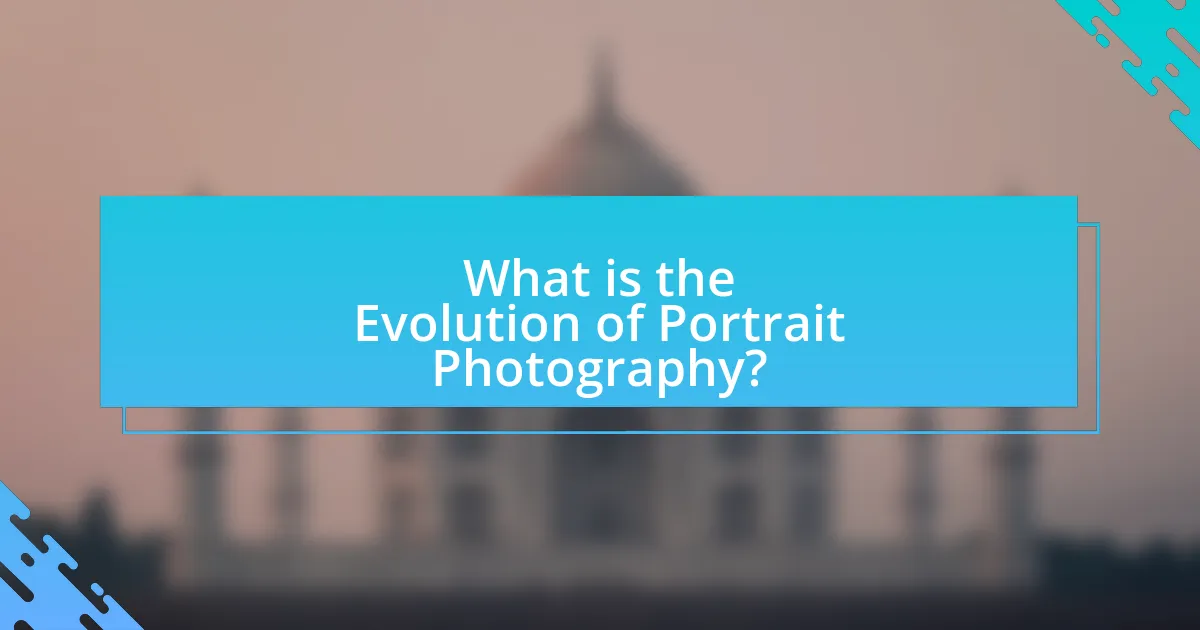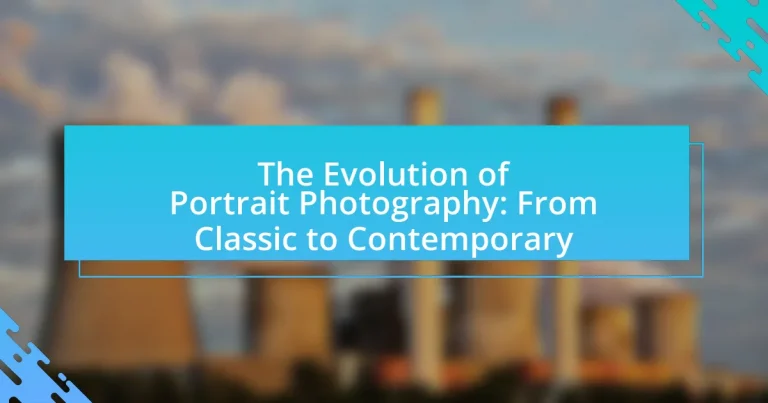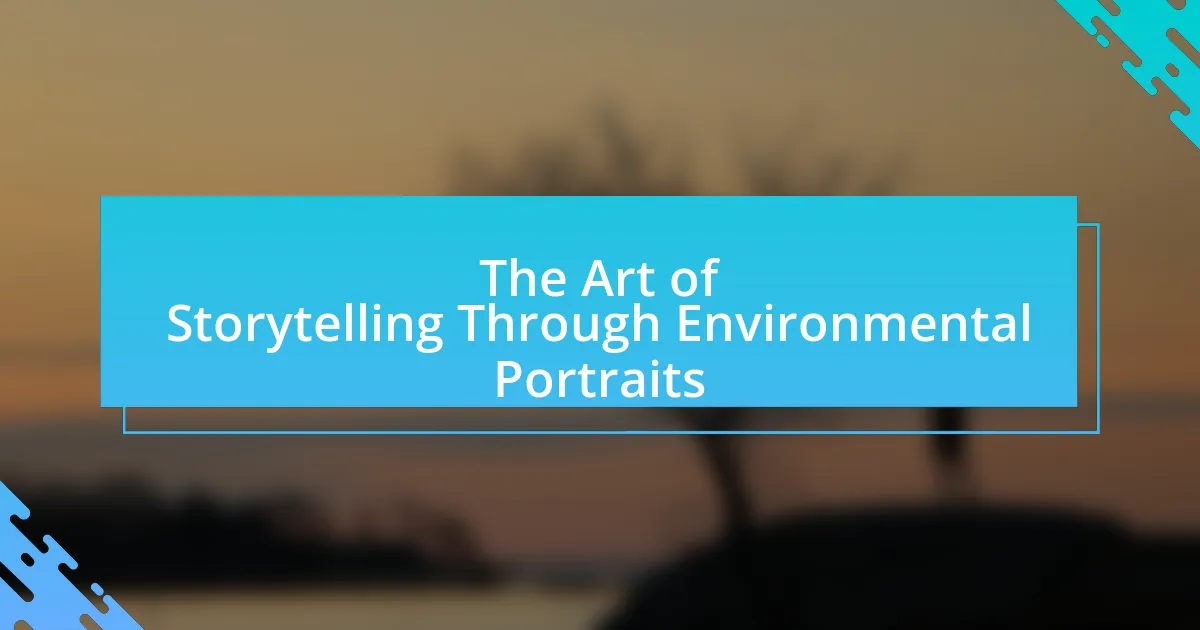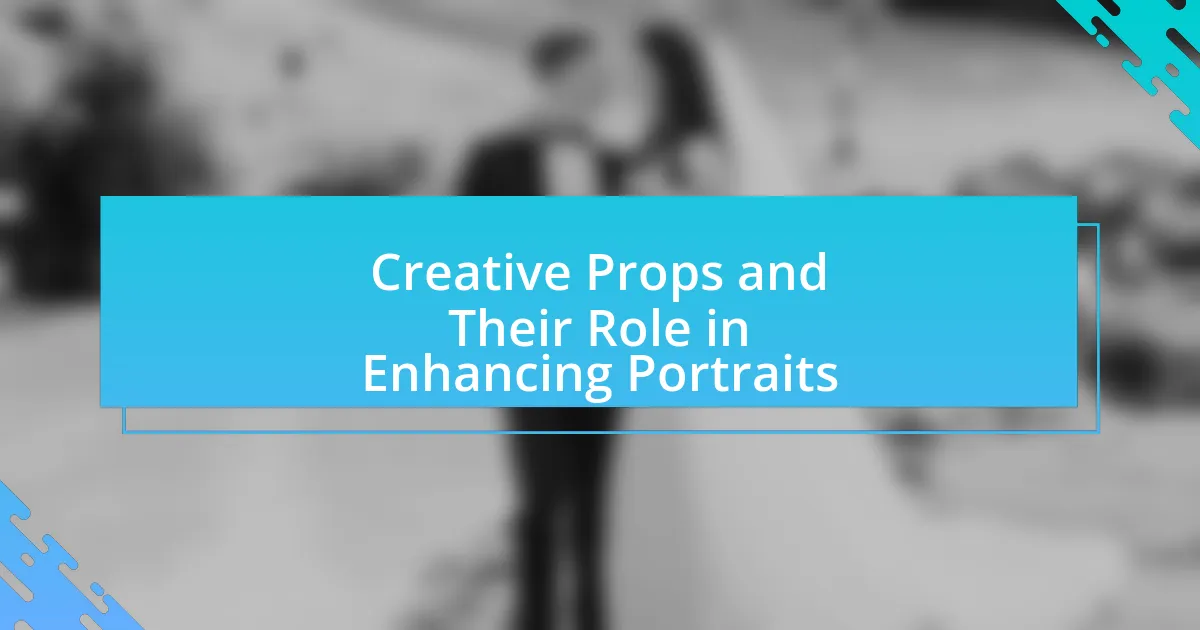The article examines the evolution of portrait photography, tracing its development from the early 19th century with the introduction of the daguerreotype to contemporary practices influenced by digital technology and social media. Key milestones include the transition from painted portraits to photographic methods, advancements in camera technology, and the rise of candid and diverse styles. The article highlights how societal changes and technological innovations have shaped portrait photography, reflecting broader cultural shifts in identity and self-expression. Additionally, it discusses classic styles, influential photographers, and emerging trends that emphasize authenticity and personal narratives in modern portraiture.

What is the Evolution of Portrait Photography?
The evolution of portrait photography began in the early 19th century with the advent of the daguerreotype, which allowed for detailed and permanent images. This innovation marked a shift from painted portraits, which were time-consuming and expensive, to photographic portraits that were more accessible to the general public. By the late 1800s, advancements in camera technology and film development further democratized portrait photography, enabling more spontaneous and candid styles. The introduction of color photography in the mid-20th century expanded artistic possibilities, while contemporary portrait photography often incorporates digital manipulation and diverse cultural influences, reflecting a broader range of identities and experiences. This progression illustrates how technological advancements and societal changes have continuously shaped the practice and perception of portrait photography.
How has portrait photography changed over time?
Portrait photography has evolved significantly over time, transitioning from formal, posed images to more candid and diverse representations. In the 19th century, portrait photography primarily involved studio settings with rigid poses and limited expressions, as exemplified by the works of pioneers like Matthew Brady. The introduction of faster film and portable cameras in the 20th century allowed for more spontaneous and natural portraits, as seen in the works of photographers like Henri Cartier-Bresson. Today, digital technology and social media have further transformed portrait photography, enabling instant sharing and a focus on authenticity, as evidenced by the rise of selfie culture and platforms like Instagram. This evolution reflects broader societal changes in how individuals perceive identity and self-expression.
What were the key milestones in the history of portrait photography?
The key milestones in the history of portrait photography include the invention of the daguerreotype in 1839, which was the first practical method of capturing images, allowing for detailed portraits. The introduction of the tintype in the 1850s made photography more accessible and affordable, further popularizing portrait photography. The development of roll film in the late 19th century enabled quicker and more spontaneous portrait sessions. The advent of color photography in the mid-20th century transformed portrait styles, allowing for more vibrant and realistic representations. Finally, the rise of digital photography in the late 20th century revolutionized portrait photography by providing instant results and extensive editing capabilities. Each of these milestones significantly shaped the techniques and accessibility of portrait photography throughout history.
How did technological advancements influence portrait photography?
Technological advancements significantly influenced portrait photography by enhancing image quality, accessibility, and creative possibilities. The introduction of the daguerreotype in the 1830s marked the first major leap, allowing for detailed and permanent images, which made portrait photography more popular among the public. The development of roll film in the late 19th century further democratized photography, enabling quicker and more spontaneous portrait sessions. Additionally, the advent of digital photography in the late 20th century revolutionized the field by allowing for instant review and editing, thus expanding artistic expression and accessibility for both professional and amateur photographers. These advancements collectively transformed portrait photography from a labor-intensive process into a versatile and widely practiced art form.
Why is the evolution of portrait photography significant?
The evolution of portrait photography is significant because it reflects societal changes, technological advancements, and artistic movements over time. As photography transitioned from painted portraits to daguerreotypes in the 19th century, it democratized access to personal representation, allowing a broader range of individuals to capture their likenesses. This shift is evidenced by the rise of amateur photography and the establishment of photography as a legitimate art form, highlighted by the work of pioneers like Julia Margaret Cameron and Alfred Stieglitz. Furthermore, the evolution has led to contemporary practices that challenge traditional notions of identity and representation, as seen in the works of modern photographers who explore themes of culture, gender, and self-expression.
What cultural shifts have impacted portrait photography styles?
Cultural shifts such as the rise of individualism, the influence of social media, and the democratization of technology have significantly impacted portrait photography styles. The shift towards individualism, particularly in Western societies, has led to a focus on personal identity and self-expression in portraits, moving away from traditional, formal poses to more candid and authentic representations. Social media platforms like Instagram have popularized informal and spontaneous photography, encouraging styles that prioritize relatability and immediacy over classical aesthetics. Additionally, advancements in smartphone technology have made photography accessible to a broader audience, resulting in diverse styles that reflect various cultural backgrounds and personal narratives. These shifts illustrate how societal changes directly influence the evolution of portrait photography.
How does portrait photography reflect societal changes?
Portrait photography reflects societal changes by capturing the evolving identities, values, and cultural norms of different eras. For instance, during the Victorian era, portrait photography emphasized social status and formality, showcasing elaborate clothing and poses that signified wealth and propriety. In contrast, contemporary portrait photography often embraces diversity and authenticity, highlighting individual expression and social issues such as gender identity and racial representation. This shift is evidenced by the rise of movements like the Black Lives Matter campaign, which has influenced photographers to focus on marginalized communities, thereby documenting and advocating for social justice. Such changes in portrait photography not only mirror societal transformations but also serve as a historical record of cultural evolution.

What are the Classic Styles of Portrait Photography?
Classic styles of portrait photography include traditional, environmental, candid, and glamour portraits. Traditional portraits focus on posed subjects, often in a studio setting, emphasizing formal attire and backdrops. Environmental portraits capture subjects in their natural surroundings, providing context about their lives or professions. Candid portraits depict subjects in spontaneous moments, showcasing genuine emotions and interactions. Glamour portraits highlight beauty and fashion, often using dramatic lighting and styling to create an idealized image. These styles have historical significance, with traditional portraits dating back to the Renaissance, while environmental and candid styles gained popularity in the 20th century, reflecting changes in societal norms and artistic expression.
What techniques were commonly used in classic portrait photography?
Classic portrait photography commonly utilized techniques such as soft lighting, posed compositions, and the use of backdrops. Soft lighting was achieved through diffused natural light or artificial sources, creating flattering shadows and highlights on the subject’s face. Posed compositions involved careful arrangement of the subject’s body and facial expressions to convey personality and emotion, often guided by the photographer’s direction. Backdrops, ranging from simple fabric to elaborate painted scenes, were employed to enhance the subject’s presence and context within the portrait. These techniques were foundational in establishing the aesthetic and emotional impact of portrait photography during its classic era.
How did lighting play a role in classic portrait photography?
Lighting was crucial in classic portrait photography as it defined the subject’s features and mood. The use of natural light or controlled artificial light sources allowed photographers to create depth, highlight textures, and emphasize facial expressions. For instance, Rembrandt lighting, characterized by a triangle of light on the cheek opposite the light source, became a standard technique to enhance the three-dimensionality of the subject. Historical practices, such as the use of softboxes and reflectors, further refined the quality of light, ensuring that portraits conveyed the desired emotional tone and character of the subject.
What poses were popular in classic portrait photography?
Classic portrait photography commonly featured poses such as the three-quarter turn, where the subject’s body is angled slightly away from the camera while the face is turned towards it. This pose was popular because it created a sense of depth and dimension, enhancing the subject’s features. Additionally, seated poses with the subject’s hands resting on their lap or on a chair arm were frequently used, as they conveyed a sense of relaxation and formality. The use of profile poses, where the subject is captured in side view, was also prevalent, allowing for a strong emphasis on facial structure. These poses were favored for their ability to convey personality and status, aligning with the artistic conventions of the time.
Who were the influential photographers in the classic era?
Influential photographers in the classic era include Julia Margaret Cameron, Alfred Stieglitz, and Edward Weston. Julia Margaret Cameron, active in the mid-19th century, is renowned for her soft-focus portraits and innovative use of lighting, which significantly impacted portrait photography. Alfred Stieglitz, a key figure in the early 20th century, championed photography as an art form and was instrumental in the development of modernist photography. Edward Weston, known for his striking still lifes and nudes, emphasized form and texture, influencing the aesthetic direction of photography. These photographers collectively shaped the artistic landscape of portrait photography during the classic era.
What contributions did these photographers make to the art form?
These photographers significantly advanced the art of portrait photography by innovating techniques and expanding the expressive potential of the medium. For instance, pioneers like Julia Margaret Cameron introduced soft focus and dramatic lighting, which emphasized emotion and character, influencing the aesthetic of portraiture. Similarly, Alfred Stieglitz’s work in the early 20th century elevated photography to fine art, advocating for the artistic merit of the medium through his gallery, 291, and his promotion of modernist photography. Additionally, contemporary photographers such as Annie Leibovitz have redefined portraiture by blending celebrity culture with personal storytelling, utilizing elaborate settings and conceptual themes to create iconic images. These contributions collectively shaped the evolution of portrait photography, making it a dynamic and multifaceted art form.
How did their work shape the perception of portrait photography?
Their work significantly transformed the perception of portrait photography by introducing innovative techniques and artistic approaches that emphasized individuality and emotional depth. Pioneers like Julia Margaret Cameron and Richard Avedon challenged traditional norms by focusing on the subject’s personality and inner life rather than merely capturing their physical likeness. Cameron’s soft-focus style and Avedon’s stark, high-contrast portraits highlighted the emotional narratives behind the subjects, thereby elevating portrait photography to an art form that conveys complex human experiences. This shift in focus from mere representation to storytelling has fundamentally influenced contemporary portrait photography, encouraging photographers to explore and express the unique identities of their subjects.

What are the Contemporary Trends in Portrait Photography?
Contemporary trends in portrait photography include the use of natural light, candid and unposed styles, and the integration of technology such as digital editing and social media platforms for sharing. Natural light is favored for its ability to create soft, flattering images, while candid styles capture genuine emotions and interactions, moving away from traditional posed portraits. Additionally, photographers increasingly utilize digital tools for retouching and enhancing images, and social media serves as a primary outlet for showcasing their work, influencing trends and styles in real-time. These trends reflect a shift towards authenticity and accessibility in portrait photography.
How has digital technology transformed portrait photography?
Digital technology has transformed portrait photography by enabling instant image capture, editing, and sharing. This shift from film to digital has allowed photographers to take numerous shots without the cost of film, leading to greater experimentation and creativity. Additionally, advancements in software have made it possible to enhance images with precision, apply filters, and retouch portraits efficiently. The rise of social media platforms has further changed the landscape, allowing photographers to showcase their work to a global audience instantly, thus influencing trends and styles in portrait photography.
What are the advantages of using digital tools in portrait photography?
The advantages of using digital tools in portrait photography include enhanced image quality, greater flexibility in editing, and efficient workflow management. Digital cameras provide higher resolution images, allowing for more detail and clarity, which is essential in capturing the nuances of a subject’s features. Additionally, digital editing software enables photographers to make precise adjustments to lighting, color, and composition, significantly improving the final output. Furthermore, digital tools streamline the workflow by allowing instant review of images, reducing the time spent on film development and enabling quicker turnaround for clients. These benefits collectively enhance the overall quality and efficiency of portrait photography.
How do social media platforms influence contemporary portrait styles?
Social media platforms significantly influence contemporary portrait styles by promoting trends that prioritize visual aesthetics and personal branding. These platforms, such as Instagram and TikTok, encourage users to share visually striking images, leading to the rise of styles that emphasize bold colors, unique compositions, and curated appearances. For instance, the popularity of filters and editing tools on these platforms has transformed traditional portrait photography, allowing for enhanced creativity and personalization. Additionally, the viral nature of social media trends can rapidly shift the focus toward specific styles, such as minimalism or maximalism, as seen in the widespread adoption of certain poses or backdrops that gain traction online. This dynamic interaction between social media and portrait photography reflects a broader cultural shift towards visual storytelling and self-expression in the digital age.
What are the emerging styles in contemporary portrait photography?
Emerging styles in contemporary portrait photography include environmental portraits, which capture subjects in their natural surroundings, and conceptual portraits that convey deeper narratives or themes. Additionally, the use of mixed media, such as combining photography with digital art or collage techniques, is gaining popularity. These styles reflect a shift towards personalization and storytelling, allowing photographers to express individuality and creativity. The rise of social media platforms has also influenced these trends, as photographers seek to create visually striking images that resonate with online audiences.
How do modern photographers incorporate mixed media into their work?
Modern photographers incorporate mixed media into their work by blending traditional photography with various artistic techniques, such as painting, digital manipulation, and collage. This approach allows them to create unique visual narratives that challenge conventional boundaries of photography. For instance, artists like David Hockney have famously combined photographs with painting to produce vibrant, multi-perspective portraits, demonstrating how mixed media can enhance storytelling and emotional depth. Additionally, the use of digital tools enables photographers to layer images and textures, further expanding their creative possibilities. This integration of different media not only enriches the aesthetic quality of the work but also reflects contemporary themes and cultural dialogues in portrait photography.
What role does personal expression play in contemporary portrait photography?
Personal expression is central to contemporary portrait photography, as it allows subjects to convey their individuality and emotions through visual representation. This form of photography emphasizes authenticity and personal narratives, often utilizing elements such as styling, setting, and pose to reflect the subject’s identity. For instance, contemporary photographers like Annie Leibovitz and Tyler Shields have gained recognition for their ability to capture the essence of their subjects, showcasing personal stories and unique perspectives. This shift towards personal expression marks a departure from traditional portraiture, which often focused on idealized representations, thus highlighting the evolving nature of the medium in reflecting contemporary societal values.
What practical tips can enhance portrait photography today?
To enhance portrait photography today, utilize natural light effectively by positioning subjects near windows or outdoors during golden hour. This technique improves skin tones and reduces harsh shadows, resulting in more flattering images. Research indicates that natural light can enhance the aesthetic quality of photographs, as it creates a soft, diffused effect that is often more appealing than artificial lighting. Additionally, employing a shallow depth of field can help isolate the subject from the background, drawing attention to facial features and expressions. This approach is supported by the fact that portraits with blurred backgrounds tend to engage viewers more effectively, as they focus on the subject.
How can photographers effectively use natural light in their portraits?
Photographers can effectively use natural light in their portraits by understanding the quality, direction, and time of day for optimal lighting conditions. Utilizing soft, diffused light during golden hour—shortly after sunrise or before sunset—creates flattering skin tones and reduces harsh shadows. Additionally, positioning subjects near windows or in shaded areas can enhance the natural light effect, allowing for a more even illumination. Studies show that natural light can improve the emotional impact of portraits, as it often conveys a sense of authenticity and warmth, which is crucial in portrait photography.
What are the best practices for posing subjects in portrait photography?
The best practices for posing subjects in portrait photography include ensuring the subject’s body is angled slightly away from the camera, which creates a more flattering silhouette. Additionally, positioning the subject’s chin slightly forward and down helps to define the jawline and avoid unflattering shadows. It is also effective to have the subject relax their shoulders and engage their eyes to convey emotion, as this draws the viewer’s attention. Research indicates that these techniques enhance the overall aesthetic appeal of portraits, making them more engaging and visually pleasing.

















